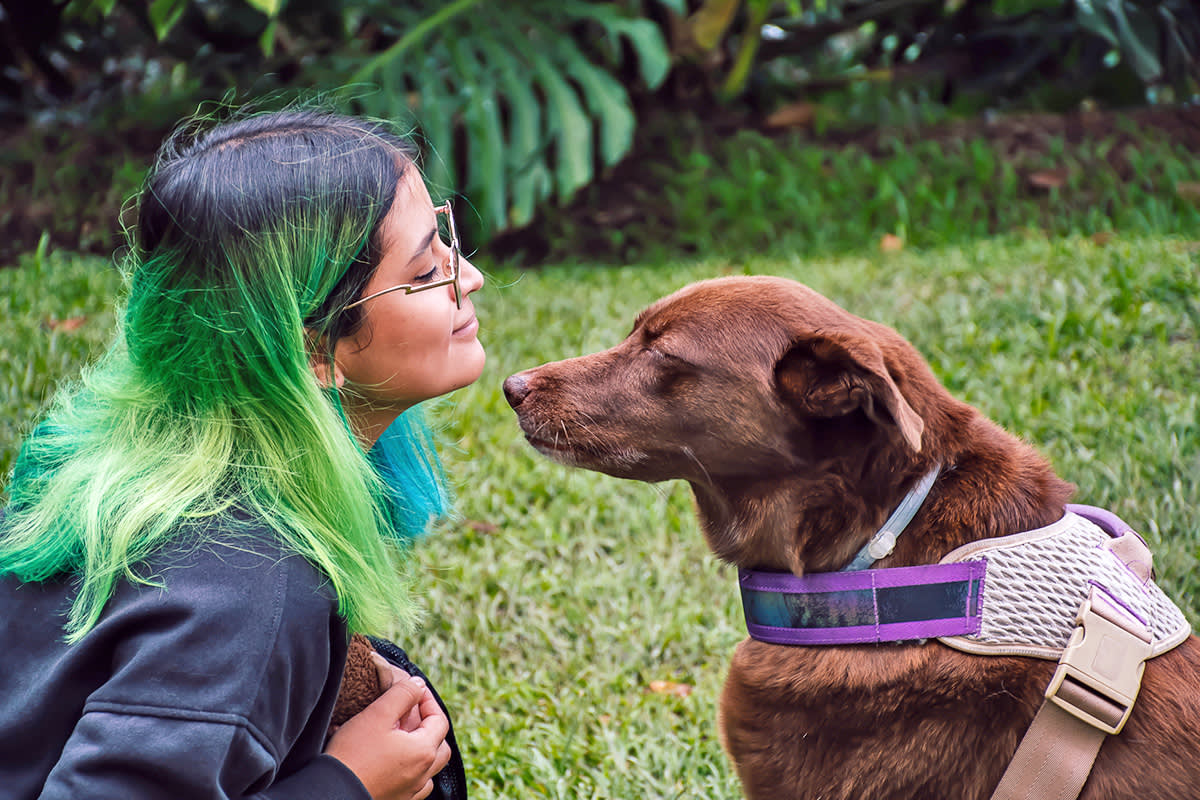Should You “Gentle Parent” Your Dog?
If it’s good for kids, it’s probably good for dogs, too.

Share Article
A lot of people think of their dog as their kid. Or surrogate kid. Or starter kid. And until or unless they have human children, they can’t imagine loving anything as much as they love their pup. And that makes perfect sense. Our pets are our kids; they depend on us, give us love and joy, and sometimes, they challenge us. And we, in turn, are better people because of them. So, it makes sense that we would want only the best for them, which means adopting the most modern parenting techniques to raise them. Enter: gentle parenting (no, this is not a Parents article or an interview for a Montessori school — stick with us).
Gentle parenting opens in new tab is a strategy to raising human children that emphasizes connection, respect, and understanding, and prioritizes building strong relationships through positive reinforcement and guidance rather than punishment. “More than anything, gentle parenting is about leading with your heart,” says Dr. Yasmine Saad of Madison Park Psychological Services.
At Kinship, we’ve already determined that parenting styles apply to dog parents (and even discussed the idea that how you were raised influences how you raise your pup). We also know helicopter parenting isn’t uncommon around the dog park, so it’s only reasonable that gentle parenting is, too. Here are eight ways you can apply this approach to your own perfect pup.
How can you gentle parent your dog?
This method is not easy. It requires mindfulness, awareness, and a willingness to learn. “You also have to let go of moral judgments (good, bad, etc.) and any attachments you might have to the way you want things to be,” Dr. Saad adds. “When you are attached to a certain outcome or way of being, you are in reactive mode — not curious or compassionate mode — and that makes it very hard to gentle parent.”

So, what does this look like when your kid is a dog?
1. Train using positive reinforcement.
Not only do dogs learn better when they are rewarded for good behavior — as opposed to being punished for bad behavior — but their relationship to you, their person, grows deeper and happier.
2. Get curious about why your dog does the things they do.
This means not naming certain behaviors as good or bad but rather trying to understand where the behavior is coming from. For instance, if your dog is pooping in the house, instead of getting upset with them, try to ask yourself why and see what you can do to address whatever issue is causing the dog to act this way.
Are you taking them out for walks often enough or at the right times? Is your dog sick or in pain and trying to communicate that something is wrong? Has anything changed in the house recently? Getting mad at your dog is unlikely to change the behavior because it doesn’t address the root cause. In order to find out what that is, you have to set your emotions and your judgments aside and really understand what is going on in your dog’s environment, brain, and body to make them act this way.
3. Check in about how your dog is feeling.
Dogs can’t tell you how they are feeling with words, but “they are always communicating through body language,” says professional dog trainer and certified dog behavior consultant Kate LaSala, of Rescued By Trainingopens in new tab. So, it is essential that you learn to read the signals they are giving you and respect them. “If a dog is unsure, for example, they might shift their weight onto their back legs or lick their lips or yawn,” she says. “Some of these cues can be harder to recognize than others, but they are always there.”
Dogs, unlike people, don’t lie. They don’t hide things. When they have a feeling, they act on it. And it’s important that you allow them to do that. If, for example, you are grooming your dog, and they indicate that they are done being groomed for now — either by getting up and walking away or by some other means — a gentle-parenting move would be to let them have that break. You can always resume grooming later or come back to it another day.
A gentle parent would also try to figure out why your pup wanted the grooming to stop. Maybe they can only stand to be brushed or washed for 10 minutes, and you will have to build up to longer grooming sessions over time. Maybe they have some physical sensitivity in a particular area, so now you’ll know to tread carefully next time.
4. Plan ahead for less-than-favorable behaviors.
When you know what could trigger your dog, you can plan ahead to avoid putting them in that situation in the first place. For example, maybe you know there is a possibility that your dog will get into a fight with another dog at the dog park — perhaps through no fault of their own. Knowing this, you might avoid that park completely or only go there when you know the other pup won’t be present. You could also train your dog to be better at recall and keep a super high-value treat in your pocket to get their attention and coax them away if an issue arises.
If, despite your best efforts, the other dog is there, a gentle parenting action would be to notice the issue, try to physically (and safely) block your dog from seeing the other dog, then lead them out of the park as calmly as possible. Avoiding triggers and potentially dangerous situations also requires that you be vigilant when you are out with your dog. You can’t be on the lookout and also be looking at your phone.
5. Learn from experience and adjust your own behavior first.
If you learn that something upsets your dog or doesn’t serve them the way you thought it would, make a change. Don’t expect them to just get used to it. It’s very tempting to simply say, “Oh, he doesn’t like this, but it’s fine. We can do it anyway.” A gentle parent, however, will do what it takes to change themselves and their own approach to the problem, knowing that is the best way to change the outcome.
6. Establish and maintain a good routine.
A huge part of gentle parenting (and the part that many people neglect) is setting boundaries and being firm. With kids, this means being explicit about schedules (bed time, homework time, etc.) and expectations. And even if kids are initially or sometimes resistant to these restrictions, structure and boundaries are ultimately nurturing and will help them thrive.
Dogs also benefit tremendously from structure. For example, you should try to walk and feed them at the same time every day. You should also endeavor not to give them mixed signals about certain behaviors. If, for example, you don’t want them to jump up on people, but you sometimes allow them to jump up on you during play, that is sending them a mixed signal that is ultimately going to make it harder for them to behave consistently. A gentle parent recognizes the importance of consistency and puts their own wants and feelings aside in order to prioritize it.
7. Lean in to teamwork.
Gentle parenting means recognizing that you and your dog are a team, and it’s your job, as the coach, not to boss your dog around, but to figure out how best to work with them.
“When it comes to dogs, there are always going to be things we have to do for them,” LaSala says. “For example, you might need to trim your dog’s nails, but you can do what’s known as cooperative care training and teach them to lie on their side and offer you their paw. And, of course, if they opt out at some point — removing their paw or walking away — you can give them the time and space to do that.”
8. Respect your dog’s autonomy.
Your dog has their own wants, needs, and interests, which may or may not align with yours. Take walks for example: You might think the best part of a walk is going out in the fresh air and getting in some extra steps. But your dog might really only be interested in sniffing every square inch of a certain block. The walk is your dog’s time, not yours, and a gentle parent will recognize that and give them the space to do what they want at that time.
“Honestly, walks are overrated anyway,” LaSala says. “If your dog just wants to sniff around for 30 minutes, let them. There are other ways for them (and you) to get exercise and enrichment.”
How does gentle parenting a dog differ from using this method with kids?
Even if you think of your dog as your child and treat them accordingly, there are still fundamental differences between human brains and dog brains and between human development and dog development. So, is it really possible to apply a parenting technique — this technique — to a dog? Or is it doomed to fail?
Much of modern dog training and behavior analysis already overlaps with gentle-parenting principles, per LaSala: “Modern dog training, as opposed to old, dominance-based methods, which have been debunked again and again, already prioritizes empathy, understanding, and positive reinforcement over punishment.”
This doesn’t mean that gentle parenting a dog is exactly the same as with a child. After all, it involves a lot of shared empathy. While research has concluded that dogs can sense their parents’ emotions through smell, we still can’t have a full-on conversation with them about their feelings like we can with other humans.
Dogs also don’t have the same kind of self-awareness as humans. Most dogs, for example, don’t recognize themselves in a mirror. And self-awareness is another important part of gentle parenting, both for the parent and for the child. Self-awareness allows kids to self-assess, and that’s not really something dogs can do. As far as we can tell, dog’s don’t examine their own thoughts, feelings, and motivations (at least not in the same way we do).
What’s the takeaway here?
But just because dogs don’t grow and learn from gentle parenting in exactly the same way human children do, it doesn’t mean that the principles of the method cannot be applied to training. They absolutely can, if you’re willing to put in the work.
At the end of the day, gentle parenting, whether it is applied to a dog or a human child, is really about setting your own wants, feelings, and prejudices aside and trying to see situations from the other being’s perspective. To do this effectively, you have to work on regulating your own emotions. And you have to be unafraid to reexamine past mistakes and negative outcomes, to grow from them, and to change your own behavior before expecting others to change theirs.
It’s a lot of work. But if you can, the bond between you and your dog will be stronger than ever and more fulfilling than you can possibly imagine.

Charles Manning
Charles Manning is an actor and writer based in New York City. In his free time he likes to cook, go swimming at the public pool, volunteer at the LGBTQ senior center, and foster senior and special-needs cats. His work has previously appeared in Cosmopolitan, Elle, Marie Claire, Harper’s Bazaar, Seventeen, and Nylon.
Related articles
![Bodil Jane illustration, someone waters a garden with a brown dog in it]()
Nature vs. Nurture: Does Your Parenting Style Influence Your Pet’s Behavior?
Your personality may actually have something to do with your pet’s personality.
Do Anxious Dog Parents Raise More Anxious Dogs?
Which comes first: a nervous person or a nervous pup?
![]()
Parenting a Dog Isn’t So Different From Raising a Kid, After All
OK, OK, don’t come for us. We know dogs and kids are very different to raise, but this study finds they respond to different parenting styles in similar ways.
![Woman training cute white puppy to behave and new tricks in summer meadow.]()
Why You Shouldn’t Be Skeptical of Positive Training Methods
It is powerful enough, even for the tough cases, and it is the best choice—here’s why.
![Woman holding black dog.]()
Pet Parent Guilt Is Very Real—Here’s How to Stop Feeling So Bad About It
It’s a super common feeling, but it isn’t always healthy.
![Dog trainer reinforcing good behavior with a young boxer dog on a dog training field]()
These Reinforcement Techniques in Dog Training Will Make Rules Fun for Both of You
Offering fewer treats can actually be a good thing.








